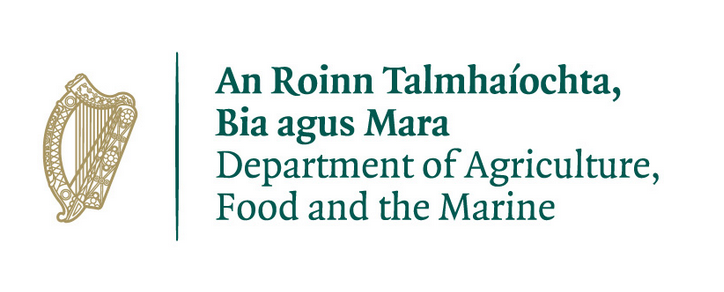Irish Wildlife Crime Conference 2013
Comhdháil Coireacht Fiadhúlra na hÉireann - 19 CVE credits
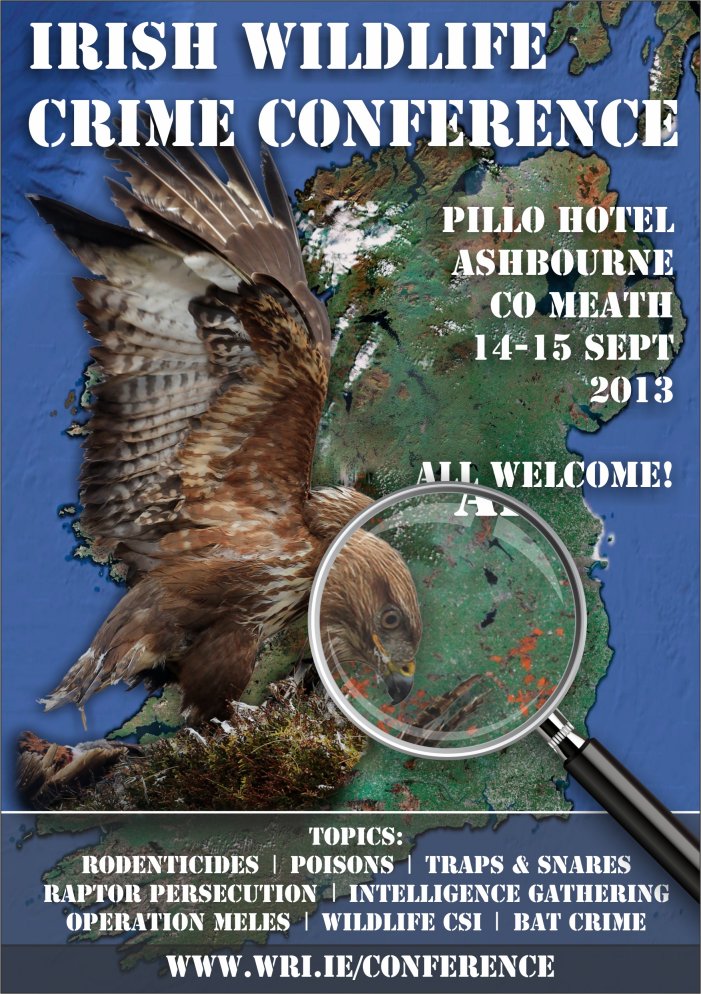
Programme – 14th September 2013
Venue: The Pillo Hotel, Ashbourne, Co Meath
Delegates: Open Attendance
| 08.30 | Registration & Coffee | |
| 09.00 | Welcome address | |
| 09.10 | Ministerial address on the Government’s commitment to tackle wildlife crime in Ireland | Minister of State – Fergus O’Dowd, T.D |
| 09.30 | Vision for & and priorities of National Parks and Wildlife Service for prevention of wildlife crime | Feargal O’Coigligh (NPWS) |
| 09.50 | Persecution of reintroduced raptors; how eagles limit wildlife predation | Lorcan O’Toole (Golden Eagle Trust) |
| 10.20 | Introduction to the NPWS and Department of Agriculture joint ‘Poison Surveillance Scheme’ | Dr Barry O’Donoghue (NPWS) |
| 10.40 | Questions & Answers | |
| 10.50 | Coffee | |
| 11.10 | Royal Society for the Protection of Birds’ (RSPB) investigations into wild bird crime in the UK | Bob Elliot (RSPB) |
| 11.45 | Alan Stewart’s case studies – illegal trapping, poaching, destruction of nest sites, hare lurching | Alan Stewart (National Wildlife Crime Unit) |
| 12.25 | Ireland’s deer poaching epidemic; causes, methods used, prevention, and impact on our deer population | Damien Hannigan (Wild Deer Association of Ireland) |
| 12.45 | Lunch & Exhibitions | |
| 13.45 | PRACTICAL Poisons: identification & field signs of poisoned wildlife |
Bob Elliot (RSPB) |
| Rodenticides and Raptors – how legal use of substances can also impact wildlife | Damian Clarke (NPWS) | |
| 14.45 | PRACTICAL Poisoned wildlife casualties: modes of action, sampling & packaging of cadavers for toxicology tests |
Mícheál Casey (Dept of Agriculture, Fisheries and Food) |
| 15.45 | PRACTICAL Traps and Snares: identification, purposes, safe and legal vs illegally set or illegal devices |
Roy Thompson, Val Swan (NPWS), A.S, B.E, I.H |
| 16.45 | Introduction to Wildlife Rehabilitation Ireland / Questions & Answers | |
Programme – 15th September 2013
Venue: The Pillo Hotel, Ashbourne, Co Meath
Delegates: Open Attendance
| 08.30 | Registration & Coffee | |
| 09.00 | Welcome address | |
| 09.10 | Vision for & priorities of An Garda Síochána for prevention and prosecution of wildlife crime | Chief Superintendent Fergus Healy (Gardai) |
| 09.30 | Wildlife crime prosecution case studies and the obstacles faced in the pursuit of prosecution | Inspector Martin Walker (Gardai) |
| 09.50 | Crimes against bats: roost disturbance/destruction, exclusion from buildings, vandalism | Enda Mullen (NPWS) |
| 10.20 | Wildlife Crime – Police Service of Northern Ireland (PSNI) perspective | Emma Meredith (PSNI Wildlife Liaison) |
| 10.40 | Questions & Answers | |
| 10.50 | Coffee | |
| 11.10 | ‘Operation Meles’: an intelligence-led UK police operation gathering evidence of badger persecution, & badger baiters’ motivation & mindset | Ian Hutchison (Scottish badgers) |
| 11.50 | Intelligence; the bedrock of effective and successful investigation | Colin Pirie (National Wildlife Crime Unit) |
| 12.15 | Introduction to Partnership for Action Against Wildlife Crime (PAW) | Dr Jon Lees (NIEA) |
| 12.35 | Questions & Answers | |
| 12.45 | Lunch & Exhibitions | |
| 13.45 | PRACTICAL Scene of Crime Examination: Badgers – crime-scene reconstruction, gathering evidence, lab tests & forensics |
Ian Hutchison |
| 14.45 | PRACTICAL Scene of Crime Examination: Birds, Traps & Snares – crime-scene reconstruction, gathering evidence, lab tests & forensics |
Bob Elliot, Alan Stewart |
| 16:00 | PRACTICAL Discussion forum; how to advance the fight against wildlife crime in Ireland? |
Facilitated by Maurice Eakin |
| 16:45 | Introduction to Wildlife Rehabilitation Ireland / Raffle | |
GUEST SPEAKERS
We look foward to welcoming the speakers listed below:
Mícheál Casey
Mícheál Casey grew up in Westport Co. Mayo.
He is currently based in The Department of Agriculture, Food & the Marine’s main Laboratory Campus at Backweston, Co Kildare where he is the head of the Regional Veterinary Laboratory Division.
He graduated in Veterinary Medicine from UCD’s Veterinary College in 1989. He graduated from the University of London with a Masters Degree in Livestock Health and Production in 2001. After three years lecturing in Veterinary Parasitology, he spent five years in veterinary practice in Co. Mayo, during which time he set up his own mixed practice in Westport.
He joined the staff of the Regional Veterinary Laboratory in Sligo as a Research Officer in 1997 and was promoted to Senior Research Officer in charge of Sligo RVL in 2004. In June 2010, he took responsibility for the Regional Veterinary Laboratories and the Brucella Testing Laboratory in Cork as the first head of the newly formed Regional Veterinary Laboratory Division.
He sees Animal Health Ireland as a unique opportunity to weave together all the different efforts to address the control of endemic disease in Irish food animals, and to unite the key people in the agricultural industry, the state service, the private sector, and the veterinary profession in a common cause. He sees the veterinary laboratory service as an important component of the Animal Health Ireland project, providing key technical and diagnostic components to the ambitious work programme of AHI.
Damian Clarke
Conservation Ranger with the National Parks & Wildlife Service, and previously the project manager of the Red Kite re-introduction project.
Bob Elliot
Bob is Head of Investigations for the Royal Society for the Protection of Birds (RSPB). His role involves his team assisting police and others in investigating crimes committed against some of the rarest species in the UK and in Europe (via BirdLife partners).
Bob is originally from North Yorkshire and started his conservation career as the National Trust’s Head Warden on the Farne Islands monitoring the large seabird colonies and welcoming visitors. A move to Scotland in 1993 led to a career in Countryside Rangering with the National Trust for Scotland, and as Countryside Manager he moved to Inverness to manage the NTS Highlands and Islands properties. These include some of the most iconic landscapes and wildlife in the Trust’s portfolio, including the islands of Fair Isle, Iona, Canna, Staffa and St Kilda, as well as the mainland properties of Glencoe, Inverewe and Culloden.
As a skilled field naturalist, helping people to understand and enjoy the countryside is one of Bob’s passions, and in recent years, he has led expeditions to Peru, Iceland, the Arctic, Antarctica and many Scottish islands.
Damien Hannigan
Damien is Director & Secretary of the Wild Deer Association of Ireland
The Wild Deer Association of Ireland, are the lead organisation representing those with an interest in our wild deer herds and those involved in their management for over 30 years. A significant part of their work involves working with various state agencies and stakeholders in tackling the current wildlife crime epidemic in particular the illegal killing of wild deer. They also play a significant role in drafting and influencing relevant legislation and have a voice in the EU through their membership of FACE.
They run a number of campaigns supported by the various stakeholders on wildlife crimes such as “Shine a light on poaching” which helps creates public awareness and “Report a wildlife crime” which is an online tool for reporting of all wildlife crimes, they have also featured recently on RTE & TG4 highlighting wildlife crimes. The association operates voluntary poaching patrols throughout Ireland and have a large support base on social media which they use as a platform to highlight and gather information on wildlife crimes.
Fergus Healy
Chief Superintendent Fergus Healy – An Garda Síochána
Ian Hutchison
Ian is a retired police officer from Tayside Police and during the latter years of service worked part time as a wildlife liaison officer for Eastern Division covering the glens of Angus.
On retiring he turned his attention to badgers and their protection and for some years he has represented Scottish Badgers as their species protection officer which has brought him into contact with the problems badgers face through criminal persecution as well as the impacts of development, forest and agricultural operations.
He is also the crime prevention lead for Operation Meles an intelligence led operation targeting badger persecution as part of the UK Wildlife Crime Priorities. This position, funded by Scottish Badger and The Badger Trust, has meant travelling throughout the UK promoting awareness of badger crime.
Jon Lees
Dr Jon Lees has been with the Northern Ireland Environment Agency for a little over 9 years and currently works as a Wildlife Officer within the Biodiversity Unit. This is a diverse role which involves licensing administration and providing advice across of three main areas of work; domestic wildlife, Dangerous Wild Animals and zoo licensing. Jon has a PhD from the University of Ulster in Animal Behaviour and Conservation and a MSc from the University of Edinburgh in Animal Behaviour and Animal Welfare. Jon also enjoys wildlife photography and spends free time exploring the countryside with his camera
Emma Meredith
Emma Meredith has been the wildlife liaison officer for the Police Service of Northern Ireland since 2007. The role is a specialised position to offer advice, support and assistance to local police who investigate an alleged breach in the wildlife and/or animal cruelty legislation.
As a result of Emma’s past experience and roles she is familiar with applied and strategic wildlife conservation and legislation as well as wildlife research techniques, care of captive wildlife and aviculture.
Emma is an active member of the Partnership for Action against Wildlife Crime (PAW). The PAW group aim to combat wildlife crime. PAW has members from government and non-government agencies and it continues to grow. The group was chaired recently by the Minister of the Environment, Alex Attwood.
Emma most recently completed the Winston Churchill Scholarship and as a result published a report on animal crime and welfare. This prestigious award resulted in travelling extensively within Canada and Australia including working with organisations and officials from a suite of government and non government agencies.
Emma has successfully co-ordinated and/or assisted with international and local operations at the Northern Ireland scale, including but not limited to; Operation RAMP (illegal international trade in tortoises) and local actions including Operation WILD DEER (to raise awareness and stop illegal deer poaching at identified crime “black-spots”) and Natural Copeland (targeting eggs thieves on the Copeland Islands) and targeting specific areas on Badger Baiting. Many wildlife and animal welfare operations within the service require liaising internally with PSNI officers and staff and also external agencies and therefore championing the wildlife and animal welfare within, and on behalf of, the PSNI.
Enda Mullen
Originally from Dublin Enda Mullen has lived in Wicklow for 25 years. She has always had a very strong interest in nature conservation. During her career as a primary school teacher she ran a Wildlife Detective Club for the children and she believes strongly in educating people about our relationship to nature. Since completing a M. Sc. in Protected Area management in 1999 she has worked with the National Parks and Wildlife Service and has a particular interest in Irish bats. Her most recent research is a joint project with the Department of Agriculture, Forestry and Marine studying the impacts of a major road improvement scheme on the local badger population.
Feargal Ó Coigligh
Feargal Ó Coigligh is Assistant Secretary with responsibility for built and natural heritage issues, including biodiversity policy, at the Department of Arts, Heritage and the Gaeltacht. He previously worked in areas of local government reform, waste management, and planning policy in the Department of the Environment, Heritage and Local Government.
Barry O’Donoghue
Dr. Barry O’Donoghue is Assistant Principal Officer with National Parks & Wildlife Service of the Department of Arts, Heritage & the Gaeltacht, with particular responsibility for agri-environmental matters. Since beginning with NPWS as a Ranger in 2005, Barry has been involved in wildlife rehabilitation, law enforcement and education, all of which are relevant to this conference.
He is responsible for the implementation of the inter-departmental protocol on bird of prey poisoning and persecution, which has been central to investigating and recording wildlife crime relating. He represents NPWS on the Campaign for Responsible Rodenticide Use. Along with colleagues in NPWS, the Regional Vet Labs and the State Lab, and with input from various wildlife rehabbers, he has recently produced the first two annual reports on Bird of Prey Poisoning and Persecution in Ireland (2011 and 2012), which he will present to us.
Lorcan O’Toole
Project Manager, Golden Eagle Trust
Colin Pirie
I spent the majority of my Police service in the CID and specialist units investigating and dealing with major crime and drugs, and operating as a surveillance officer, intelligence officer and CHIS handler. On retirement I remained in Force as a Local Intelligence Officer before moving to my present position at the National Wildlife Crime Unit in 2006.
David Scallan
Dr. David Scallan is a geographer with an interest rural policy, ecology and recreational hunting. He received his PhD in 2012, which examined the role of hunting activities in contemporary rural Ireland, in the Department of Geography, National University of Ireland Galway.
He is the Public Relations Officer (PRO) with the National Association of Regional Game Councils (NARGC), which is the largest hunting and conservation non-governmental organisation in Ireland. More specifically, it is the principle national organisation representing the interests of individuals involved in game shooting.
The Association was formed in 1968 and currently enjoys a membership of 27,000 individuals. These members, who pay an annual fee, are spread throughout 965 Gun Clubs all over the country – a Club in almost every parish. The NARGC is a Seanad Nominating Body on the Agricultural Panel. Its individual Clubs are also “Recognised Bodies” under the Wildlife Acts. This is a recognition unique to NARGC Clubs, which essentially means that the Clubs are entitled to take prosecutions for offences under the Wildlife Acts. Through his role as PRO of the NARGC, David has worked with a range of state agencies and NGOs interested in wildlife conservation.
Alan Stewart
I joined Perth and Kinross Constabulary in 1966, serving first of all as a police officer in Dunblane. I was then transferred to Perth shortly before Perth and Kinross Constabulary was amalgamated with Dundee City Police and Angus Constabulary to form Tayside Police. In these early days I very much specialised in dealing with poaching cases, particularly the poaching of salmon and deer. Since that time I have served at Force Headquarters, Crieff and Kinross. Most of my service since 1980 was spent in CID and HQ Drug Squad, which covered the whole force area. I retired as a serving officer in 1997 with the rank of inspector, and also having had the role of force wildlife crime officer for the previous four years. After 6 hours retirement – possibly one of the shortest ‘retirements’ on record – I was re-employed as the force wildlife crime officer in a civilian capacity, an appointment probably helped by my knowledge of dealing with poaching, and a huge interest in natural history, farming, shooting, fishing and the countryside in general.
In 1999 I was presented with the WWF UK Wildlife Enforcer of the Year Award, and received the MBE for services to policing in 2001, followed by a Lifetime Achievement Award in 2006. I was presented with a Chief Constable’s Certificate of Merit in 2007 in recognition of my wildlife law enforcement work. As can be seen under ‘Books’ I am the author of four books on wildlife crime, the first, Wildlife Detective, being written to accompany the BBC 2 series Wildlife Detectives, a TV series following my work and that of several of my colleagues in other police forces in Scotland.
I retired in 2011, and now, apart from maintaining an acre and a half of garden, am working part-time with the UK National Wildlife Crime Unit. I have also just completed a year-long wildlife survey on a sporting estate in Highland Perthshire with an amazing biodiversity of birds and mammals. During the year I identified 89 species of birds including tree pipit, white-tailed eagle, redstart, goshawk, red kite and, something not seen on too many estates, at least eight nesting pairs of buzzards.
I live on the outskirts of the village of Methven in Perthshire with my wife, Jan, a dog, guinea pig (in the kitchen) and ordinarily around 16 to 24 khaki Campbell ducks. I have three daughters, four grand-daughters and a grandson. My main hobbies now are gardening, writing, giving talks, watching wildlife in the garden and walking in the countryside.
Val Swan
Retired Conservation Ranger, National Parks and Wildlife Service
Roy Thompson
Coming from a farming background, and lifelong involvement in sustainable hunting, I studied in the UK, obtaining a BTEC National Diploma in Game, Wildlife and Habitat Management from Sparsholt College, Hampshire, in 1991.
Later that same year I joined NPWS as a Wildlife Ranger (the grade was later re-named ‘Conservation Ranger’) and was based in East Galway for a time, later transferring to Wicklow Mountains National Park for three years before again re-locating to my native Kildare, where I have been based since 1999.
In a career spanning more than two decades, I have had a keen interest in the illegal hunting side of wildlife crime, and have successfully prosecuted cases particularly relating to unlawful traps and snares. It is an area in which I am particularly interested.
Early instruction in lawful, sustainable methods of hunting by a particularly enlightened father, along with training received from a progressive head Game Keeper on a sporting estate in the UK, and 20 years on the job experience in the field have contributed to a belief that there is little or no excuse for employing methods of trapping and snaring other than those prescribed by law, and to a commitment to detect and prosecute hunters operating outside the law.
Martin Walker
I have 31 years service as a member of An Garda Síochána.
Spent 24 years as a Garda and Sergeant working and living in West Wicklow, and continue to reside in Blessington.
I am the Inspector for County Carlow since 2007and direct on all investigation files and prosecute weekly in the District Court.
THE FIRST IRISH WILDLIFE CRIME CONFERENCE
Laying foundations for a new awareness and collaboration
In September 2013, Wildlife Rehabilitation Ireland (WRI) ran Ireland’s first All-Ireland Wildlife Crime Conference. It brought together an extremely diverse audience of over 150 delegates, for a weekend of talks and practical sessions, with the intention of promoting greater understanding, cooperation and communication between the law enforcement agencies, charities, NGOs and the public in general.
Much work has been put into animal protection legislation in Ireland and WRI believe it can be most effectively implemented by ensuring communication and cooperation at all levels. The conference aimed to establish and enhance effective and cordial working partnerships throughout the island of Ireland. This was the first time that such a conference had been convened to discuss wildlife crime in a comprehensive all-island context and, as such, WRI hoped it would prove to be a historic milestone in Irish wildlife protection.
The conference was addressed by national and international speakers and addressed a wide variety of issues including bird poisoning, poaching, badger baiting, forensics, and the use of illegal traps and snares.
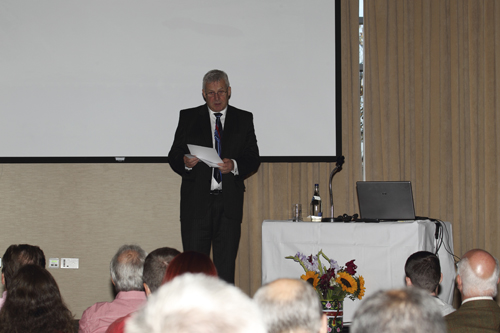
Minister Fergus O’Dowd
The opening address was given by Fergus O’Dowd, T.D who is Minister of State at the Department of Communications, Energy & Natural Resources.
Minister O’Dowd explained how “one of my roles, and that of Inland Fisheries Ireland (IFI) is to highlight how wildlife crime effects us all… It should be no surprise to anyone that wildlife and environmental crime can negatively impact on this image of Ireland. What should be a surprise is exactly the potential magnitude of this impact.”
The Minister explained how IFI is “bringing the fight to the poachers” via lake, river, coastal and estuarine patrols, using bicycles, quad bikes, kayaks, jetskis and RIBS. They also have a 24 hour hotline for reporting illegal activity, and utilise night vision scopes, thermal imaging equipment, covert cameras and innovatively, a new dog patrol unit.
The Minister’s presence and contribution to the conference demonstrates his commitment, on behalf of the government, to taking effective measures in tackling wildlife crime in Ireland.
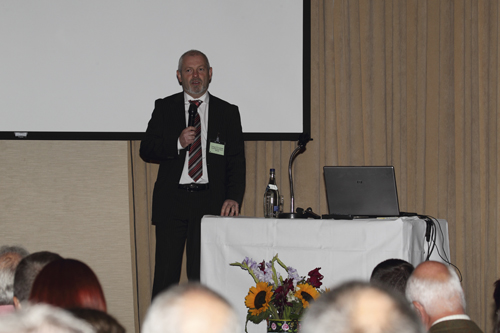
Feargal O’Coigligh
The next speaker was Feargal O’Coigligh, Assistant Secretary with responsibility for built and natural heritage issues, including biodiversity policy, with the National Parks & Wildlife Service (NPWS) of the Department of Arts, Heritage and the Gaeltacht.
“Wildlife crime does not recognise political boundaries, and like many other challenges in the biodiversity field, it is vital that we pool all our resources, knowledge and experience to help us meet common challenges.” Feargal reasoned.
The illegal rhino horn raids were also mentioned by Feargal which he said “..again confirms the international aspect of wildlife crime and the need for all of us to engage on a cross-border basis to tackle this illegal trade.”
Continuing the cross border co-operation theme, he explained he was aware of the “Partnership for Action against Wildlife Crime in Northern Ireland” (PAW NI) and that the NPWS “..will certainly look at the Northern Ireland approach in developing our further responses to increased wildlife crime.”
Feargal concluded his talk with: “I see our vision as being one of increasing awareness of the value of Ireland’s biodiversity…. I would see the NPWS …. moving from being the guardians, or police of nature conservation, to being strategic partners across a wide coalition to better deliver our collective objectives of protecting our wildlife and raising awareness.”
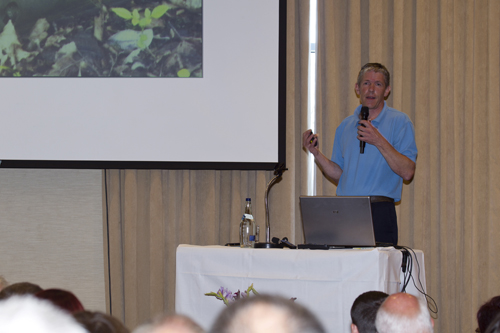
Lorcan O’Toole
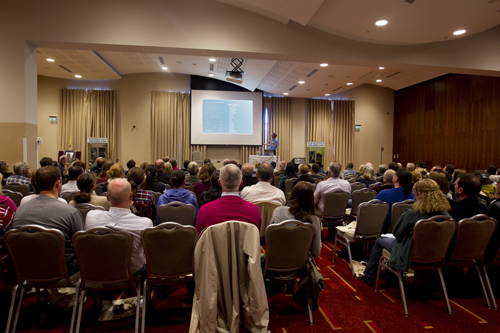
Lorcan O’Toole
Lorcan O’Toole gave a talk entitled ‘Persecution of Irish Raptors and the impact on the Irish Food Chain’.
Lorcan is Project Manager of the Golden Eagle Trust (GET) which is dedicated to the conservation and restoration of Ireland’s native birds and their habitats. The GET manages reintroduction programmes for golden eagles in Co. Donegal, white-tailed eagles in, Co. Kerry and red kites in Co. Wicklow, in partnership with the National Parks and Wildlife Service.
In his presentation Lorcan talked about the different forms of raptor persecution; poison baits, shooting, nest disturbance/burning, and the mis-use of rodenticides. Sadly poisonings have apparently accounted for the deaths of 50% of satellite tagged white-tailed eagles deaths and 30% of satellite tagged golden eagles.
According to Lorcan, poisoning still seriously threatens the reintroduction project “Despite the proven support of the Donegal farming community for golden eagles, a small number of individuals continue to use poison on this island. Poisoning is still the primary threat to our vulnerable eagle population,”
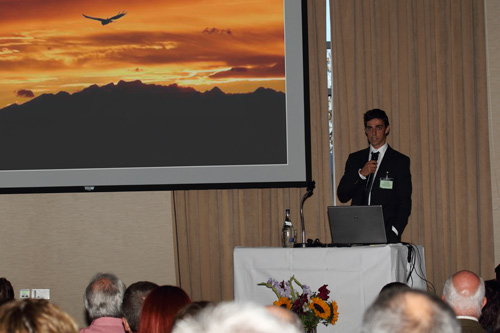
Dr. Barry O’Donoghue
Dr. Barry O’Donoghue is Assistant Principal Officer with NPWS, with particular responsibility for agri-environmental matters and he represents NPWS on the Campaign for Responsible Rodenticide Use.
Barry is responsible for the implementation of the inter-departmental protocol on bird of prey poisoning and persecution, which has been central to investigating and recording wildlife crime. Along with colleagues in NPWS, the Regional and the State Lab, and with input from various wildlife rehabbers, he has recently produced the first two annual reports on Bird of Prey Poisoning and Persecution in Ireland (2011 and 2012).
Barry explained that the information gathered is only the tip of the iceberg; most incidents go unrecorded, nevertheless the results from the Report provide intelligence that can build a picture as to bird injuries and mortalities, main pressures, and areas and effects of persecution, which in turn aid enforcement, can initiate inspections, and provide a measure of success in combating illegal persecution and poisoning.
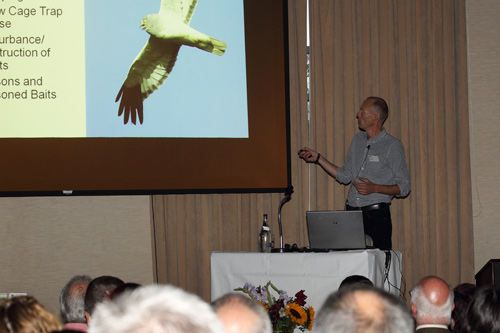
Bob Elliot
Bob Elliot gave a talk entitled ‘Catching the Killers’
Bob is Head of Investigations for the Royal Society for the Protection of Birds (RSPB) and he and his team assist police and others in investigating crimes committed against some of the rarest bird species in the UK, and in Europe via BirdLife partners.
A simplification of the legal situation that had a good ring to it was ‘All birds are protected….but some are more protected than others!’ A few of the illegal activities the RSPB assist the police in dealing with are; egg collecting, shooting, trapping, crow cage trap abuse, disturbance/ destruction of nests and poisons and poisoned baits, and Bob used case studies to explain how his team help catch the culprits.
He also explained how in Scotland large tracts of moorland are managed for red grouse by gamekeepers and that 70% of those convicted of offences related to bird of prey persecution since 1990 were those with game interests. Favourable management of grouse moors is therefore a key aspect of conserving rare ‘priority species’ birds such as the hen harrier.
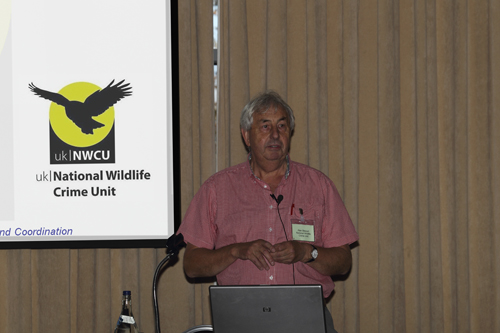
Alan Stewart
Alan Stewart works as a wildlife crime Intelligence Officer with the UK National Wildlife Crime Unit and his passion and tireless dedication to his work has led him to being a leading authority on wildlife protection law.
In his talk Alan used personal case studies (from his former role of police wildlife crime officer) to highlight illegal activities such as – illegal trapping, poaching, destruction of nest sites and hare lurching, and explained how the criminals’ incompetence and the involvement of the wider community often brought the perpetrator to justice, or in the case of unintentional breaches of the law by construction companies, provided a satisfactory solution for both developer and wildlife.
Alan provided photos of all manner of illegally set traps and snares that he has come across over the years, and explained how the legislation surrounding these devices is anything but straightforward.
In conclusion, Alan pointed out that “there are well-known criminal links between Ireland and mainland UK in relation to deer poaching, hare coursing, badger baiting, finch trapping and the provision of pesticides. Already intelligence from the NPWS on a cage-bird enthusiast from Scotland suspected of laundering finches taken from the wild, provided grounds to obtain a search warrant for his aviary, in which wild-taken birds were recovered. As well as making it more difficult in Ireland for ‘home grown’ wildlife criminals to evade detection, I would hope that through this ground-breaking conference we can also exchange intelligence to make it much less attractive for people to travel throughout the British Isles to indulge in wildlife criminality.”
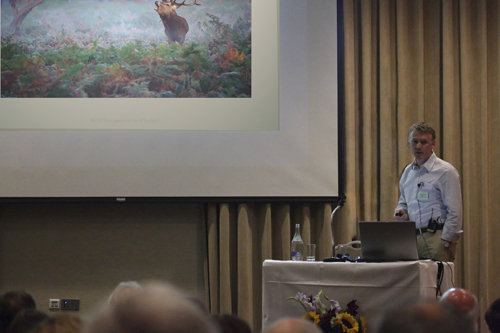
Damien Hannigan
Damien Hannigan gave a presentation entitled “Ireland’s deer poaching epidemic; causes, methods used, prevention, and impact on our deer population”
Damien is director and secretary of the Wild Deer Association of Ireland (WDAI) who represent those with an interest in Irish wild deer herds and those involved in their management. Pressure on deer is rising via our increased road network, reduced habitat, and most dramatically and worryingly; deer poaching has increased significantly.
According to Damien, the motivation for deer poaching is mainly financial, and the poaching methods can be dangerous and barbaric. Signs of poaching activity, such as lights and unfamiliar vehicles at night, should be reported to the gardaí and NPWS.
To try to combat poaching, WDAI run a number of campaigns such as “Shine a light on poaching” which helps creates public awareness and “Report a wildlife crime” which is an online tool for reporting of all wildlife crimes. The association is calling for urgent close co-operation between agencies and stakeholders to help tackle the poaching epidemic.
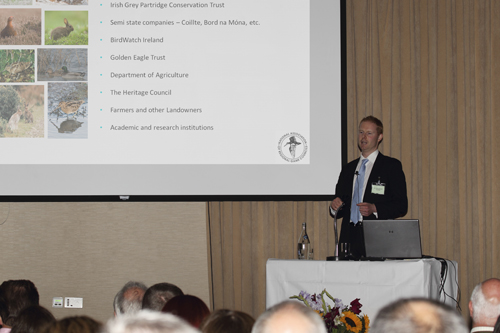
Dr David Scallan
Dr David Scallan gave a talk on “The criminality associated with commercial tourist game-bird hunting in Ireland”
David is the Public Relations Officer with the National Association of Regional Game Councils (NARGC), which is the national organisation representing the interests of individuals involved in game shooting.
The Association has members throughout 965 Gun Clubs all over the country.
David’s talk was specifically concerned with the repercussions of unregulated tourist game-bird hunting. He reported that there is a large black economy associated with this issue and that the behaviour of some tourists and their Irish hosts and guides is of paramount concern to the NARGC. David related problems such as trespass, shooting out of season, shooting non-huntable species and confrontation with landowners as reasons for the Minister to announce a commencement date for Section 36 Wildlife (Amendment) Act 2000 – legislation (prepared 13 years ago) that provides for regulation of tourist promoters through a licensing system.
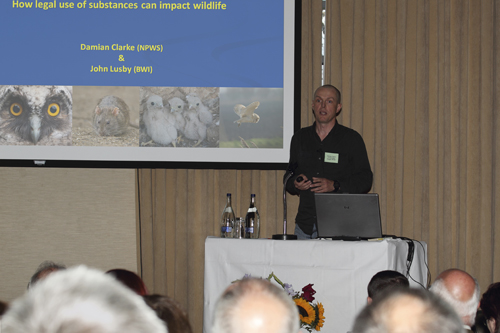
Damian Clarke
The afternoon sessions on both days of the Conference were practical, interactive and discussion focused.
Damian Clarke, Conservation Ranger with the NPWS, presented data from John Lusby’s four-year study of owl carcasses. John is the Raptor Conservation Officer with Birdwatch Ireland and unfortunately he was unable to attend the conference to present his own work. The presentation that Damian delivered on his behalf was titled ‘Rodenticides & Raptors’
John Lusby’s study proves that the unrestricted use of rat and mice poisons is causing widespread and significant exposure in Barn Owls in Ireland. In terms of tackling the problem, John was quoted as having said “It is necessary to use rat poisons in certain circumstances but by implementing small changes to the way we use these substances we can significantly reduce the threat to non–target species,”
Damian finished John’s presentation by explaining that these ‘small changes’ that John mentioned, are outlined in the ‘CRRU Code’. The Campaign for Responsible Rodenticide Use has been set up to ensure that effective rodent control can be carried out by all users, while ensuring that the exposure of all non-target animals is kept to an absolute minimum. The ‘CRRU Code’ describes the ‘do’s and don’ts’ regarding the use of poisoned baits and stresses the need to adhere to ‘good practice’.
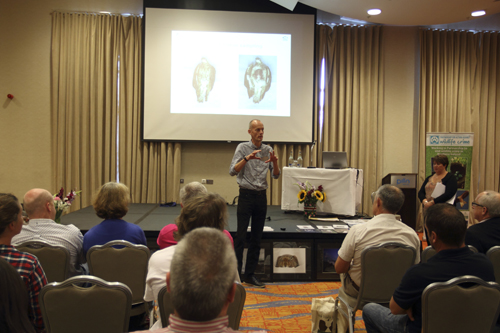
Bob Elliot & Elizabeth Sharp
Following the talk on rodenticides, the delegates were divided into three groups and were rotated around three simultaneous presentations.
Bob Elliot and Elizabeth Sharp did a joint talk on ‘Poisons: Field Signs’
Elizabeth is the Senior Analyst in the Chemistry Section, Pesticides & Wildlife Branch of Science and Advice for Scottish Agriculture (SASA) and is involved with the Wildlife Incident Investigation Scheme (WIIS) which investigates suspected poisoning of animals where there is evidence to implicate pesticides.
Bob and Elizabeth used case studies to explain how poisoning incidents are investigated, Bob heading the investigative side of things and then passing the poisoned animal to Elizabeth for analysis.
They explained how indiscriminate and dangerous poisoning is; affecting domestic pets, birds such as crows and gulls, and in particular carrion feeders such as buzzards, kites and eagles.
As certain poisons are potentially fatal to humans who may come into contact with them, delegates were also made aware of signs of a baited animal, and the appearance of chemicals commonly used on baits, e.g. Carbofuran, Aldicarb, and Alphachlorolose.
The advice given if someone comes across a suspected baited animal is to obtain a grid reference of the location, take photos of the scene, and write a description with as much detail as you can provide, and report the incident asap to the police.
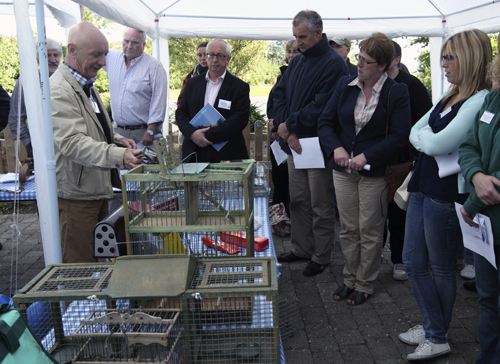
Val Swan
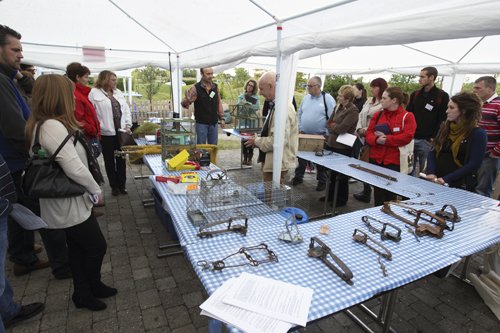
Val Swan and Roy Thompson
Roy Thompson and Val Swan spent the afternoon out in a marquee surrounded by a substantial array of both legal and illegal traps and snares, which they used for their practical session.
Roy is a Conservation Ranger with the NPWS and has a Diploma in Game, Wildlife and Habitat Management. Val has retired from the NPWS, and is one of the most experienced law enforcement officers in Ireland, regularly contacted for advice.
Together they demonstrated the use and mis-use of the different props, and explained the legal situation regarding their placement and design. The subject provoked heated discussion about ethics, and many questions from the delegates.
What appeared to come as a shock to a number of the delegates was that there are legal traps and snares at all! It seems to be a relatively common misconception that all traps and snares are illegal.
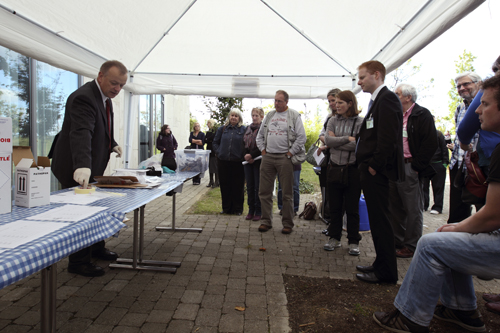
Mícheál Casey
Mícheál Casey’s practical session was titled ‘Poisoned wildlife casualties: modes of action, sampling & packaging of cadavers for toxicology tests’.
Mícheál is based in the Department of Agriculture, Food & the Marine’s main Laboratory Campus at Backweston, Co Kildare where he is the head of the Regional Veterinary Laboratory Division.
A national protocol to investigate and document incidents of bird of prey persecution was established by the NPWS, the Veterinary Laboratory Service and the State Laboratory in 2011. The protocol aims to monitor the impacts and prevalence of illegal poisoning and other persecution which affect Irish raptors, and is also designed to collect evidence to support prosecutions for these illegal acts. Dr. Barry O’Donoghue talked earlier about the first recently published annual report arising from this protocol, which details all confirmed incidents of raptor persecution over the first year of the scheme in 2011.
Mícheál emphasised the importance of the ‘chain of evidence’ which shows: who obtained the evidence, where and when the evidence was obtained, who secured the evidence, and who had control or possession of the evidence. He explained how photographing each stage of your handling of the ‘evidence’ can assist the case if it goes to court, and he stressed the value of correct sampling and packaging.
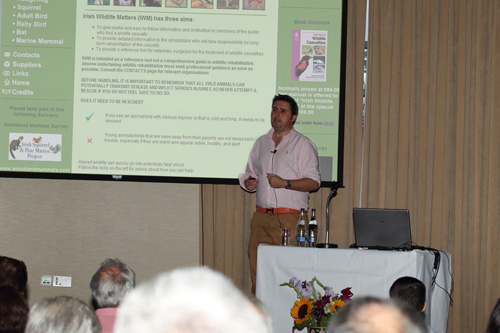
Dr Clyde Hutchinson
Dr Clyde Hutchinson, one of the directors of Wildlife Rehabilitation Ireland (WRI) gave an over-view of the work being done by WRI.
He explained that WRI exists to promote wildlife rehabilitation and improve wildlife welfare and conservation in Ireland.
WRI offers wildlife educational opportunities via conferences such as this, is in discussion with the NPWS re wildlife legislation, encourages and facilitates the raising of rehabilitation standards, collects wildlife casualty data from all Irish veterinary practices and rehabbers, and has a wildlife first aid website for injured wildlife www.irishwildlifematters.ie
SUNDAY
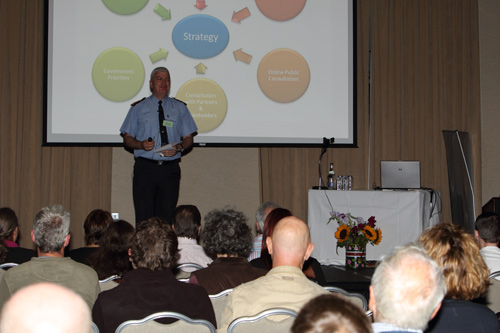
Chief Superintendent Fergus Healy
Fergus Healy, Chief Superintendent with An Garda Síochána, gave the first talk on Sunday morning on ‘The role of An Garda Síochána in the prevention and prosecution of wildlife crime’.
Successful prosecutions for wildlife related crimes between 2008 – 2012 are in single digit numbers but Fergus said that they hope to have more joint seminars with NPWS re increasing the knowledge in An Garda Síochána, as with the vast majority of gardaí being only 10 – 20yrs in the organisation, it is a constant challenge to keep their own people informed and educated.
Fergus’ message for delegates is ‘prevention and cooperation and engagement with the community’, some matters take priority over others i.e. the preservation of life, but that it is the civic duty of the general public to help, avoid the gardaí having to guess where the problems are by being the eyes and ears of the community, and providing information on local issues/concerns. He said “we want to know what’s happening on the ground and we’ll respond to it”. Input from public consultations contributes to the priorities of policing in the community, which provides a pivotal part of devising strategy.
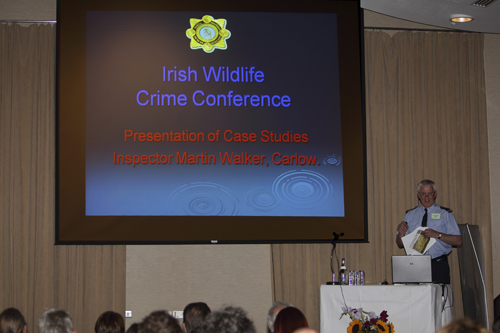
Inspector Martin Walker
Martin Walker, Inspector for Carlow, provided a presentation of wildlife crime case studies that he has brought before the courts during his 31 years service as a member of An Garda Síochána.
In his first case study, Martin talked about a deer poaching incident. The case was intelligence driven, and he explained that money is a driving factor; in this particular case, shooting 8 deer over 3-4 hrs would earn these poachers around 1000 Euro. Although in court the perpetrators were fined only 500 euro each, they also had to pay 5000 euro each to their solicitor. Later in his talk Martin talked about a horrific badger baiting case, and added that the individual concerned was the passenger from the earlier deer poaching case, who was later also arrested for dangerous driving.
In respect of wildlife crime Martin talked about ‘Policing prospectively’ and he said that “no one authority is in position to actively take on this serious crime, we’ll have to get together to work in an agency partnership, working progressively and prospectively forward.”
Due to the overwhelming problem of deer poaching; the Superintendant in Wicklow town recently appointed dedicated liaison officers, and Martin himself has nominated a liaison for animal cruelty and the wildlife act.
When, earlier, the Chief Superintendant was questioned about same, he told delegates “we don’t have a specific wildlife officer within the organisation, it’s something the Commissioner is certainly going to look at and it’s something I’ll advise him in relation to doing.”
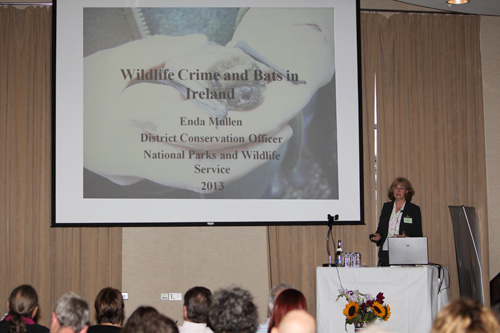
Enda Mullen
Enda Mullen’s presentation was on ‘Wildlife Crime and Bats in Ireland’
Enda has an M. Sc. in Protected Area management and is a District Conservation Officer with the NPWS in Wicklow.
After a brief introduction to bat ecology, Enda explained that not only should we protect bats (and all wildlife) because of the intrinsic value of the species, but as Ireland has a quarter of the world’s population of lesser horseshoe bats there would be serious global implications if anything should happen to them so we have obligations to keep them in favourable conservation status.
Bats are protected under four pieces of wildlife legislation in Ireland, and the legislation impacts all manner of people; developers/builders can be negligent in their mitigation efforts as Enda pointed out in one of her case study examples. Local Authorities/engineers, pest control companies and traders have also fallen foul of the wildlife act in regard to bats. The people who tend to commit most of the crimes against bats are ordinary people in their own homes; Enda explained that to combat this, there is a huge need for education to allay people’s fear and misconception of bats.
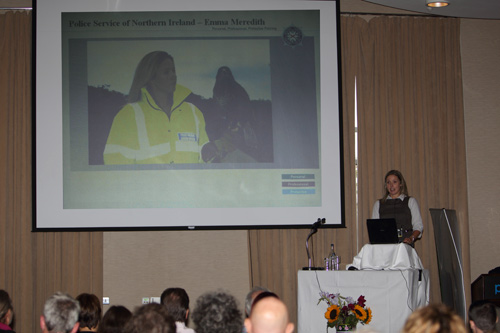
Emma Meredith
Emma Meredith’s presentation was ‘Wildlife Crime – Police Service of Northern Ireland (PSNI) perspective’
Emma has been the full-time civilian wildlife liaison officer for the PSNI since 2007. The role is a specialised position to offer advice, support and assistance to local police who investigate an alleged breach in the wildlife and/or animal cruelty legislation.
The police are the main investigative body in Northern Ireland, and they work extremely closely with the Northern Ireland Environment Agency.
Emma talked about examples of wildlife and animal welfare strategic initiatives that she has successfully co-ordinated and/or assisted with, and how these require liaison internally within the PSNI and also with external agencies, e.g. Operation WILD DEER (deer poaching), and Operation RAMP (illegal international trade in tortoises).
Emma’s message was that ‘police officer’ is an overarching term, the PSNI see all officers as investigators; the police are there to uphold every aspect of the law, she says, and they will pursue wildlife criminals as energetically as any other lawbreakers. A crime is a crime.
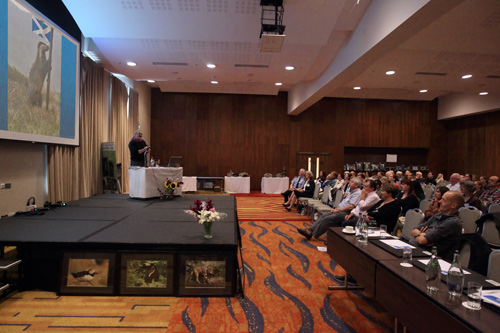
Ian Hutchison
Ian Hutchison gave a talk titled ‘Operation Meles’: an intelligence-led UK police operation gathering evidence of badger persecution.
Ian is a retired police officer who also worked as a wildlife liaison officer. He has represented Scottish Badgers as their species protection officer and he is the UK Crime Prevention Lead for Operation Meles. The objective is to “Improve and increase the recording of incidents, crimes and intelligence for Badger Persecution and to improve the investigation process and increase awareness of Badger Persecution across the UK”
Ian talked about offender profiles and how to deal with the two types of offenders. Serious offenders – people engaged in acts of extreme cruelty, commonly also involved in other forms of criminality. It is highly unlikely, he says; that these people will be caught in the act but by targeting them at home through animal welfare issues concerning their dogs it is possible to seriously disrupt their activities. To tackle the ‘Other’ offenders, Ian says we need to raise public awareness of the law as they are either people ignorant of the law or who choose to ignore it.
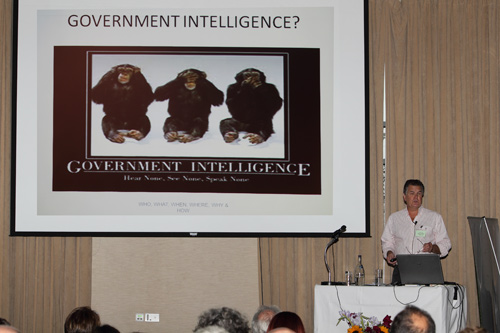
Colin Pirie
Colin Pirie continued on the Intelligence theme and gave his talk entitled ‘Intelligence; the bedrock of effective and successful investigation’
Colin is a Senior Intelligence Officer at the UK’s National Wildlife Crime Unit, (NWCU). The NWCU work extremely closely with the police and UK Border Force to assist in the prevention and detection of wildlife crime by obtaining, developing and disseminating intelligence from all UK police forces and a wide range of organisations, and by assisting and advising police forces in wildlife crime investigation.
Colin described ‘INTELLIGENCE’ as information designed for action & policy making subjected to an evaluation and a risk management process.
The collection and interpretation of intelligence is mainly used to direct future action, and Colin stressed the importance of setting aside power, ego and jurisdiction issues, in order to effectively communicate and cooperate with local and international police and NGOs, to build up a global picture of wildlife crime activities.
In terms of the future, Colin believes that Police should have standard operating procedures [SOP] for dealing with wildlife crime in the same way as SOP’s are used in every other Police Business area.
Colin posited that if we want to protect biodiversity, to alter perceptions that a wildlife species may be cost beneficial, and to prevent species extinction, then the cooperation creativity and innovation of NGO’s is an essential requirement in this partnership.
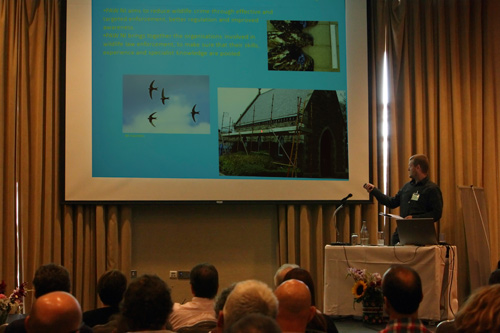
Dr Jon Lees
Dr Jon Lees gave the final talk before lunch; ‘Introduction to Partnership for Action against Wildlife Crime NI (PAW NI)’
Jon works as a Wildlife Officer within the Biodiversity Unit of the Northern Ireland Environment Agency (NIEA). The NIEA is an Agency within the Department of Environment.
PAW UK’s Steering Group sets the overarching objectives for tackling wildlife crime. It encourages, challenges and co-ordinates members’ actions to deliver outputs which help meet those objectives. The Steering Group is jointly chaired by the head of the Department for Environment Food & Rural Affairs (Defra)’s Wildlife Species Conservation Division, and the Wildlife Advisor to the Association of Chief Police Officers.
PAW NGO members support PAW’s overarching objectives in many different ways, depending on the size and nature of the organisation and the skills and experience they offer.
PAW NI was launched in Stormont in 2007, is co-chaired by the NIEA and the PSNI, and most recently by the Minister of the Environment, Alex Attwood, and is the regional wing of the UK PAW group.
PAW NI’s mission is to reduce wildlife crime through effective and targeted enforcement, better regulation and improved awareness. It brings together the organisations involved in wildlife law enforcement, statutory, non-statutory agencies and interested parties, to make sure that their skills, experience and specialist knowledge are pooled.
PAW provides a focus for action to tackle wildlife crime; publicity, education and lobbying, and exists to raise awareness of, and facilitate effective enforcement of wildlife legislation.
At the end of his talk Jon extended an invitation to conference delegates that would also fulfil PAW NI’s own future goal; to achieve better cross border links, he said “if any statutory organisations or representatives of main NGO groups would like to come up and sit in on a PAW meeting we would welcome that with open arms.”
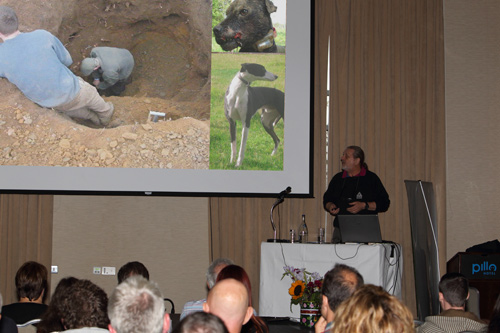
Ian Hutchison
As on Saturday, the afternoon session was interactive and discussion focused. So again after lunch, delegates were divided into three groups and were rotated around three presentations that were happening simultaneously.
Ian Hutchison this time presented a badger ‘Scene of Crime Investigations’.
Firstly Ian stressed the fact that you must remember that evidence must be gathered legally by the statutory body responsible, in order for it to be of use in a prosecution case. He explained firstly you should familiarise yourself with the wildlife legislation, and then if you come across a suspected crime scene, you’ll know what evidence is needed to prove an offence has been committed.
The Wildlife Act 1976 and The Wildlife (Amendment) Act 2000 gives protection to the “breeding or resting place” of a badger so the best piece of evidence is video footage of a badger coming out of the sett to confirm it belongs to a badger!
Taking notes is vital; ‘place, date, time, I was, I saw, I did’, then detailing the evidence you see on the sett. Things to look out for included; badger hair on trees, faeces, latrines, well worn paths, footprints, bedding etc. Evidence to look out for, which in the UK could be DNA tested, human footprints, beer tins, cigarette butts etc. As Ian pointed out, the individual could claim that he simply walked that way over the sett, but it may be enough to warrant a search that could possibly turn up the dead badger.
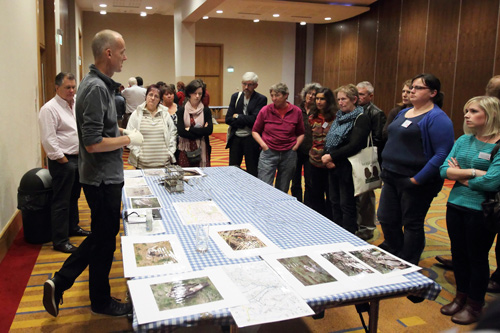
Bob Elliot practical
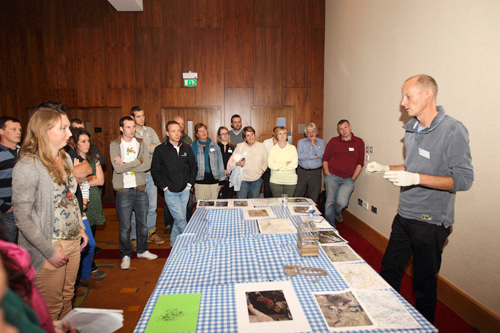
Bob Elliot practical
Bob Elliot did a ‘Scene of Crime Examination’ practical on birds, explaining the types of persecution mainly suffered by the various raptors, using case studies of incidents in which the RSPB have been involved.
Buzzards, bob said, are the litmus test of what’s going on in the environment. They are very common in the lowlands of Scotland and traditionally suffer persecution in game areas. The goshawk sadly suffers relentless persecution at the hands of those with game-shooting interests, who also tend to target low flying short eared owls and hen harriers.
Sparrowhawks are despised by pigeon fanciers and are normally trapped and killed rather than poisoned. The RSPB have found crow cage traps with live pigeons as bait, and live tethered pigeons. Nest destruction is not too common; occasionally goshawks are shot in the nest from the ground.
Bob pointed out that poison victims are not necessarily large birds of prey, but can be magpie, crows or mammals. Speckling on the breast of a dead pigeon was a sign of a possible poisoning case; confirmed by the 3 dead buzzards, and the dead stoat, that had all scavenged on the Carbofuran-coated pigeon.
Bob also talked about finch trapping, their work in Malta, and egg collecting case studies such as the serial egg collector Matthew Gonshaw; the first person to receive an ASBO restricting him from visiting Scotland during the breeding season.
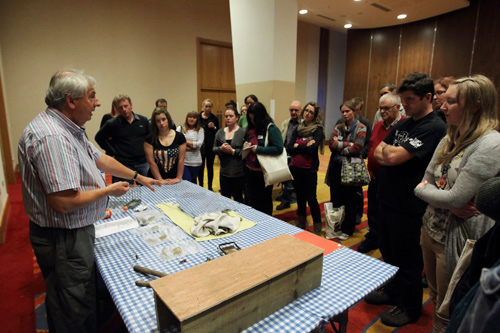
Bob Elliot practical
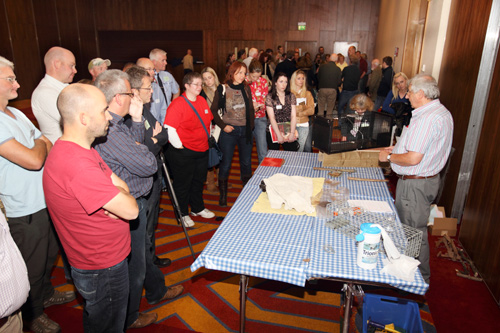
Alan Stewart
Alan Stewart did a ‘Scene of Crime Examination’ practical where he explained in great detail about gathering evidence at a crime-scene, lab tests, and forensic techniques used in Scotland in the investigation of wildlife crime incidents.
Alan explained the importance firstly of your own safety at a crime scene, then of not destroying evidence. He too reiterated the importance of writing down what you’re looking at, photography, sketching a map, and a foolproof description of the location. Obviously, ideally the gardaí or NPWS will collect the evidence at the scene, but in extenuating circumstances intervention may be warranted e.g. to preserve valuable evidence if it will be destroyed anyway, or to prevent injury to another animal.
Alan explained where to look for DNA or fingerprints on traps, snares, from spittle!, drinks bottles, cigarette packets, fibres, blood if the person cut themselves, and told how, remarkably, they had even got human DNA from a dead pigeon that had been used as bait! He also cautioned people to think about transference of evidence when collecting it.
The investigator needs evidence to link the crime scene and the victim, the victim and the suspect, the suspect and the crime scene, in order to build a case, and one of the most important tools used regularly to do this in wildlife crime situations in Scotland is DNA. ‘Reasonable suspicion’ is all that is needed Alan explained, to detain a person and then take a DNA sample. They are also fortunate enough that wildlife DNA testing is funded by the Scottish Government. In contrast, in Ireland the gardaí are limited to obtaining DNA samples only in serious crimes, or electively.
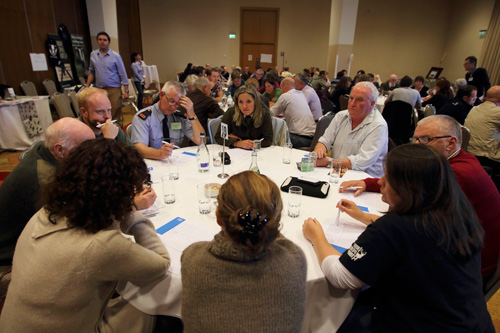
Conference discussion
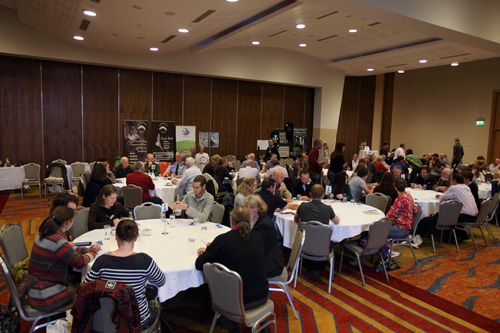
Conference discussion
Plenary Session: Conference Conclusions
The purpose of the conference was not only to inform delegates and to set up links between the different agencies and interest groups, but also to draw out wisdom, advice and a route forward from the knowledge of the delegates themselves. Maurice Eakin, District Conservation Officer with the NPWS, led and facilitated the discussion session, summarised below:
Education – There is a lack of public understanding and therefore a lack of confidence in the system. Training is vital and currently inadequate for the law enforcement agencies; reciprocal training and educational initiatives were suggested.
Legal – There is a need to define ‘wildlife crime’, and to improve consistency of penalties. The offence of ‘vicarious liability’ would be welcomed to avoid the defence of a plea of ignorance for wildlife crimes.
Collaboration – There was endorsement of the initiative to link into PAW NI, ideally government backed. There was a need for clarity in the division of responsibilities between agencies and improved inter-agency communication/cooperation and intelligence gathering structures.
Information Management – There was a call for dedicated wildlife liaison officers – either within the NPWS or the gardaí. Delegates also wanted a database of wildlife crime cases shared between the NPWS and the gardaí, as well as information leaflets to raise awareness and techniques to facilitate crime reporting.
Actions – Raise the whole profile of wildlife crime via media and social media. Engage in evidential based political lobbying by NGOs. Identify and resolve the problem areas in the existing structures. Forensic science facilities to be made available to aid the fight against wildlife crime.
For FULL Report on Plenary Session – Click HERE
Finally; most of the delegates and speakers had made reference to the fact that at least, for the first time, there was an Irish wildlife crime conference that had brought together a very large number of different agencies and interests with the combined interest and determination to tackle wildlife crime in Ireland.
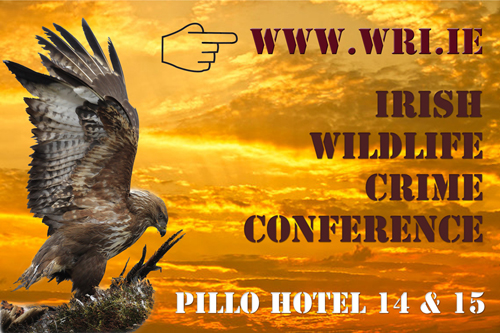
Ian Hutchison
SPONSORS
Wildlife Rehabilitation Ireland wants to extend our sincere thanks to the sponsors below
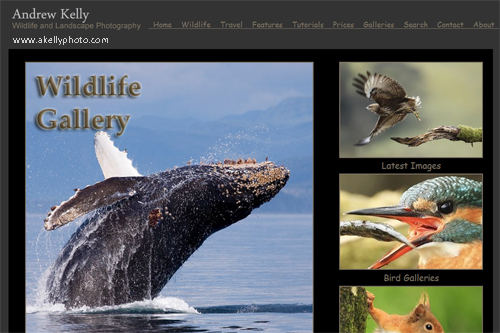
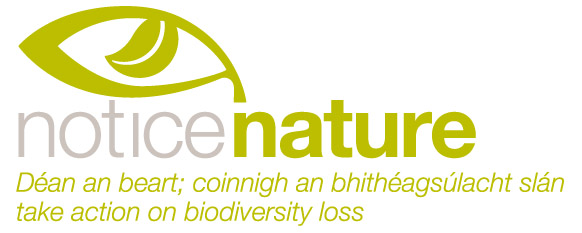
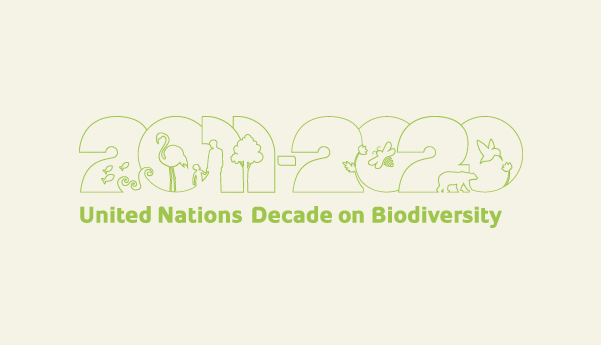
DELEGATE COMMENTS
Comments from some delegates who attended the Wildlife Crime Conference:
“
Brilliantly executed and very informative
“
Will definitely assist me in my work going forward
“
Great weekend very friendly
“
Very inspiring
“
Enlightening and thought provoking
“
Excellent weekend very informative
“
Well organised, informative and enjoyable
“
Lots of great information, very interesting weekend, well done to all involved
“
Great opportunity to spend the weekend learning and exchanging views with people with the same interests
“
Wildlife crime should be treated with the same importance as any other crime. Too often it is treated as ‘not as serious
“
Thoroughly enjoyable and educational experience
“
Huge amount of expertise in one room
“
The wildlife rehab team deserve enormous credit for organising such important conference
“
I found the conference very informative

